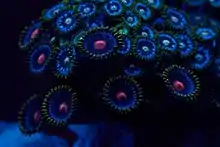Brachycnemina
Brachycnemina is a suborder of zoanthids in the order Zoantharia.[1] Genetic analysis has been used to suggest Brachycnemina is a monophyletic group diverging within the paraphyletic Macrocnemina.[1]
| Brachycnemina | |
|---|---|
 | |
| Zoanthus colony | |
| Scientific classification | |
| Domain: | Eukaryota |
| Kingdom: | Animalia |
| Phylum: | Cnidaria |
| Class: | Hexacorallia |
| Order: | Zoantharia |
| Suborder: | Brachycnemina Haddon & Shackleton, 1891 |
| Families | |
| |
Characteristics
Brachycnemia species habitate most environments, ranging from shallow tropical reefs to cold seeps in the deep sea. It forms large colonies on intertidal and shallow reef crests.[2] Due to the members of this suborder being loosely collected, there are no standard characteristics uniting them besides slight morphological, ecological and phylogenetic differences.[3]
Subdivisions
This suborder counts with 3 taxonomic families, namely Neozoanthidae, which is monogeneric; Sphenopidae, which includes sand-encrusted and colonial specimens like the commonly found Palythoa and Sphenopus, itself found in a few discrete areas; and Zoanthidae, whose belonging species do not show sand encrustation.[2] A total of 6 known genera and over 163 species are comprised within the Brachycnemina.[4] Palythoa and Zoanthus are two of the most common coral genera and are intensively studied for their bioactive compounds.[2]
References
- Sinniger, F.; Montoya-Burgos, J. I.; Chevaldonné, P.; Pawlowski, J. (2005). "Phylogeny of the order Zoantharia (Anthozoa, Hexacorallia) based on the mitochondrial ribosomal genes" (PDF). Marine Biology. 147 (5): 1121–1128. doi:10.1007/s00227-005-0016-3. ISSN 0025-3162.
- Pandya Khushali, M.; et al. (2014). "Occurrence of Zoanthid genus Isaurus from Saurashtra coast, Gujarat, India". European Journal of Zoological Research. 3 (2): 1–5.
- REIMER, James Davis (2010). "Key to field identification of shallow water brachycnemic zoanthids (Order Zoantharia: Suborder Brachycnemina) present in Okinawa". Galaxea, Journal of Coral Reef Studies. 12 (1): 23–29. doi:10.3755/galaxea.12.23. ISSN 1883-3969.
- "Brachycnemina Haddon & Shackleton, 1891". GBIF.org. GBIF.org. Archived from the original on 4 March 2016. Retrieved 21 May 2015.
Further reading
- M.B. Jones; J.M.N. Azevedo; A.I. Neto; Ana Cristina Costa; A.M. Frias Martins (11 November 2013). Island, Ocean and Deep-Sea Biology: Proceedings of the 34th European Marine Biology Symposium, held in Ponta Delgada (Azores), Portugal, 13–17 September 1999. Springer Science & Business Media. pp. 192–. ISBN 978-94-017-1982-7.
- Montenegro, Javier; Sinniger, Frederic; Reimer, James Davis (2015). "Unexpected diversity and new species in the sponge-Parazoanthidae association in southern Japan". Molecular Phylogenetics and Evolution. 89: 73–90. doi:10.1016/j.ympev.2015.04.002. ISSN 1055-7903. PMID 25863336.
- Ryland, J. S.; Lancaster, J. E. (2004). "A review of zoanthid nematocyst types and their population structure". Hydrobiologia. 530–531 (1–3): 179–187. doi:10.1007/s10750-004-2685-1. ISSN 0018-8158.
- Ryland, John S.; Lancaster, John E. (2003). "Revision of methods for separating species of Protopalythoa (Hexacorallia : Zoanthidea) in the tropical West Pacific". Invertebrate Systematics. 17 (3): 407. doi:10.1071/IS02008. ISSN 1445-5226.
- Ryland, John S.; Brasseur, Muriel M.; Lancaster, John E. (2004). "Use of cnidae in taxonomy: implications from a study ofAcrozoanthus australiae(Hexacorallia, Zoanthidea)". Journal of Natural History. 38 (10): 1193–1223. doi:10.1080/0022293031000155179. ISSN 0022-2933.